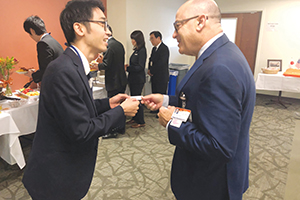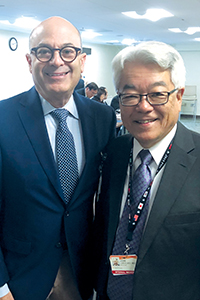By KATHLEEN NELSON
Remember the horror. Honor the survivors. Learn from the past.
As it has for the last quarter century, Dignity Health St. Mary's Medical Center in San Francisco aided and honored the survivors of the Hiroshima and Nagasaki atomic bombings by hosting a medical mission from Japan researching the aftereffects of the bombings that ended World War II.

Dr. David Klein, right, president and chief executive of Dignity Health St Mary's Medical Center in San Francisco, greets Nobuaki Nishikawa, of Hiroshima's Atomic Bomb Survivors Support Division, at a conference held at St. Mary's in October to support survivors and research the medical aftereffects of exposure to radiation from nuclear bombs.
"This was a defining moment for the Japanese people," said Sr. Mary Kieffer, OP, who up until recently was vice president of mission integration at St. Mary's, part of CommonSpirit Health. "Through the mission, we hope to repair that damage, physically and emotionally."
Three dozen survivors, known as hibakusha, gathered at St. Mary's for the three-day biennial conference in late October, some traveling more than six hours from their homes in northern and central California, circumventing the path of forest fires in the region. A seven-member team from the Hiroshima and Nagasaki prefectures collaborated with volunteers from St. Mary's to conduct hematology tests, urinalysis, liver function tests, diabetes screening, thyroid gland function testing and serum cholesterol measurements. Also included in the exams are blood pressure screenings, weight and height measurements.
Perhaps the most meaningful moments of the visit, though, are the one-on-one consultations with Japanese medical team physicians and interviews with the representatives from Hiroshima and Nagasaki, who are eager to hear the stories of the survivors.
"The hibakusha were very grateful for the fellowship," Sr. Kieffer said. "They appreciate the continued interest from the prefectures and that we open our doors to host."
Research of a lifetime
Both in and outside Japan, hibakusha suffered for years with limited medical assistance. Doctors in Japan noticed a higher incidence of leukemia among survivors versus the general population as early as 1947. Yet treatments for many of the ailments that arose because of the bombings were not covered under Japanese health care laws, and terms of the San Francisco Peace Treaty prevented victims from suing the United States for damages. Survivors also faced discrimination as the lack of research led to fears of the effects of radiation on future generations.

Dr. David Klein, left, president and chief executive of Dignity Health St. Mary's Medical Center in San Francisco, and Dr. John Umekubo, an internist affiliated with St. Mary's who has taken part in several Hiroshima/Nagasaki medical missions.
Providing aid for treatment and erasing the stigma of the hibakusha has taken decades within the country. The medical mission is an outreach of that effort. Every other year since 1977, the mission has traveled to the United States to conduct research and reconnect with survivors in such cities as Honolulu; Los Angeles; Seattle; Vancouver, Washington; and San Francisco. St. Mary's became regional host in 1995 and continues because of its alignment with the hospital's mission to serve the vulnerable.
"You want to honor the survivors and remember the mistakes of the past," Sr. Kieffer said.
Working with a local organization called Friends of Hibakusha, Sr. Kieffer coordinated volunteers from St. Mary's security, admitting and community health departments as well as the imaging and infusion centers. Friends of Hibakusha provided volunteers who speak the Hiroshima and Nagasaki dialects to communicate with the mission members as well as the survivors.
"These survivors are getting quite old and are thrilled they got to talk to clinicians and volunteers in their original dialect," she said.
Shared research
The medical mission shares its data with the Radiation Effects Research Foundation, a cooperative U.S. – Japan research organization, in what is known as the Life Span Study of survivors and a study of their children, the F1 study. The most significant findings of the Life Span Study revealed that the amount of radiation a person received standing 0.8 mile from the epicenter of either of the blasts increased the likelihood of leukemia by 4.92 times that of the general population of Japan. The risk remained elevated even 65 years after the blast.
The findings show that radiation exposure also increased incidents of:
- Breast and uterine cancer, especially among young women at the age of puberty when they were exposed to the radiation.
- Cancers of the esophagus, stomach, colon, lung, ovary, brain, thyroid and bladder.
- Elevated blood lipids.
- Cardiovascular disease.
- Cataracts.
- Uterine fibroids.
The Life Span Study also showed that the bombing had the most profound health effects on the young. The incidence of most of the cancers was higher in younger survivors than in older ones, and lower levels of cognitive function were eventually discovered among those in utero at the time of the blasts.
The study of the survivors' offspring, however, unearthed no evidence that the next generation was at a higher risk of developing cancer than offspring of unexposed parents. For that reason, the children of survivors were excluded from this medical mission for the first time.
Fewer voices to tell the stories
The Atomic Heritage Foundation estimated in 2016 that about 174,000 hibakusha remained alive, fewer than 500 in the United States. Given the dwindling number of survivors and the end to research on their children, some fear that awareness of the medical dangers from nuclear weapons will wane. Sr. Kieffer, however, said both St. Mary's and members of the medical mission intend to continue their biennial research. (Sr. Kieffer, a Dominican Sister of San Rafael, recently left St. Mary's to become administrator/moderator of Our Lady of Lourdes Convent in San Rafael, California, just north of San Francisco.)
"It's almost an antiwar statement," Sr. Kieffer said of the medical mission. "You have to keep these memories alive so you don't forget and don't repeat the past."